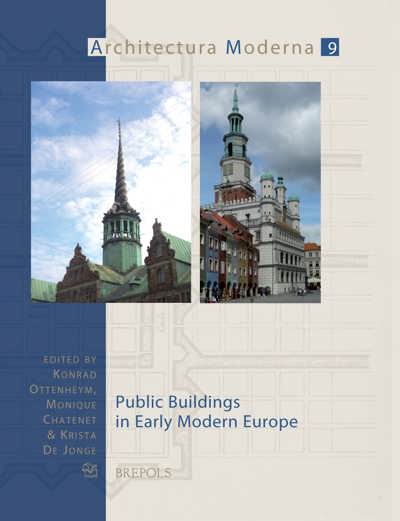
Architecture as Profession
The Origins of Architectural Practice in the Low Countries in the Fifteenth Century
Merlijn Hurx
- Pages: 459 p.
- Size:216 x 280 mm
- Illustrations:265 b/w, 16 col., 5 tables b/w.
- Language(s):English
- Publication Year:2018
- € 130,00 EXCL. VAT RETAIL PRICE
- ISBN: 978-2-503-56825-6
- Paperback
- Available
- ISBN: 978-2-503-56826-3
- E-book
- Available
“In summary, this is a very important book in setting out the workings of the building trades in and around Brussels in the late fifteenth and early sixteenth century, showing that these were significant enterprises and not merely individual craftsman working in a craft tradition (…) Hurx also does an important job in tracing the exact way instructions were passed down and designs were formulated. (…) Hurx’s book (…) contains much of interest to all those fascinated by late Medieval building production and will remain, I am sure an important point of reference for many years to come (James W. P. Campbell in Construction History, 2, 2018, p. 130-131)”
“The book can only be evaluated as impressive. It reveals a mastery of a tremendous amount of archival data, and likewise shows an intimate familiarity with the physical buildings.”(Hanneke Ronnes, in Architectural Histories, 7/1, 2019, p. 9)
“The publication of Merlijn Hurx’s Architecture as Profession marks a valuable addition to the scholarly literature on northern European architectural culture of the long fifteenth century (…) This richly detailed and eloquently written book thus deserves attention well beyond its immediate subfield.” (Robert Bork, in Speculum, 95/1, 2020, p. 261-263)
“The level of Hurx’s detailed knowledge of every aspect of late medieval and early modern design, quarrying for stone, training of skilled labor, the building process itself, and the political and social competition that spurred it all on, is truly remarkable (…) As a bonus for those who enjoy beautiful books, this one is also a stand-out, richly illustrated with a plethora of carefully explained and clearly relevant photographs, illustrations, maps, and archival documents. Even the text font and page layout design are visually stunning, making Hurx’s book a feast for both mind and eye. What better testament to his subject matter could we ask for.” (Anne E.C. McCants, in Low Countries Historical Review, 136, 2021)
Merlijn Hurx is assistant professor of architectural history at Utrecht University. He is specialised in fifteenth- and sixteenth-century architecture in the Low Countries.
Fifteenth-century Florence is generally considered the cradle of the modern architect. There, for the first time since Antiquity, the Vitruvian concept which distinguishes between builder and designer was recognised in architectural theory, causing a fundamental rupture in architectural practice. In this well-established narrative Northern Europe only followed a century later when, along with the diffusion of Italian treatises and the introduction of the all’antica style, a new type of architect began to replace traditional gothic masters. However, historiography has largely overlooked the important transformations in building organisation that laid the foundations for our modern architectural production, such as the advent of affluent contractors, public tenders, and specialised architectural designers, all of which happened in fifteenth-century Northern Europe. Drawing on a wealth of new source material from the Low Countries, this book offers a new approach to the transition from the Middle Ages to the Early Modern Period by providing an alternative interpretation to the predominantly Italo-centric perspective of the current literature, and its concomitant focus on style and on Vitruvian theory.
Introduction
Professionalisation in the nineteenth and early twentieth centuries and the ideal of the architectChapter 1. The liberty to designEconomics and the position of the architect
Design and construction
Different sources, methods and approaches
Approach and structure of the book
Defining the architectChapter 2. Urban building boomDesigns for different media
Liberal arts and the guilds’ monopoly
Patrons and guild authority
Constelyk gemaickt, artistic quality as a licence
Urbanisation in the Low CountriesChapter 3. The stone tradeCity walls
City churches
Trade halls and town halls
Princely residences
Urban architectural rivalry
The need for stoneChapter 4. Quarrying at BrusselsContracting building works
Benefits of the market
Expanding markets
Innovations in the production process
Managing the stone trade
Stones and quarriesChapter 5. Profession of the architectCommercial importance and stone politics
Brussels entrepreneurs in stone: Godevaert de Bosschere and Lodewijk van Boghem
Background and trainingChapter 6. Communicating the designChanging conditions of employment
Evert Spoorwater and Rombout Keldermans
Undermasters and methods of communication
Engineer, manager, designer
The drawing as planning instrumentChapter 7. Strategies for ‘prefab’ architectureInnovations in architectural representation
The design in words
Plain architecture by prominent architectsConclusionRepeated designs
Epilogue
Appendices
1. Money and measurements2. Projects by Evert Spoorwater, sources of table 5.1
3. Projects by Rombout Keldermans, sources of table 5.2




